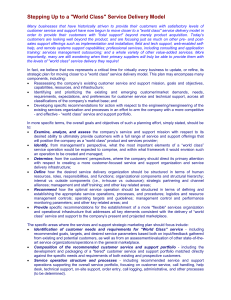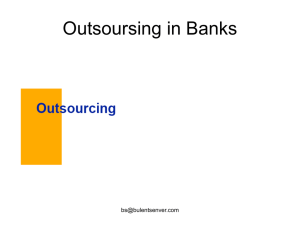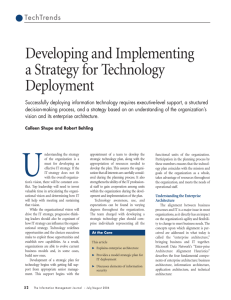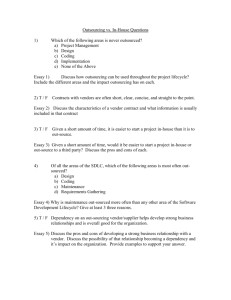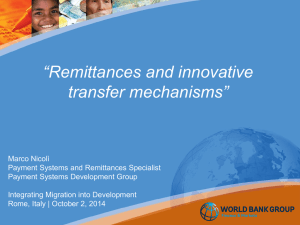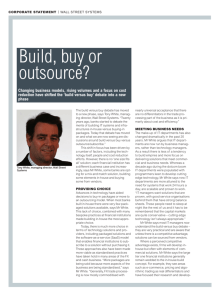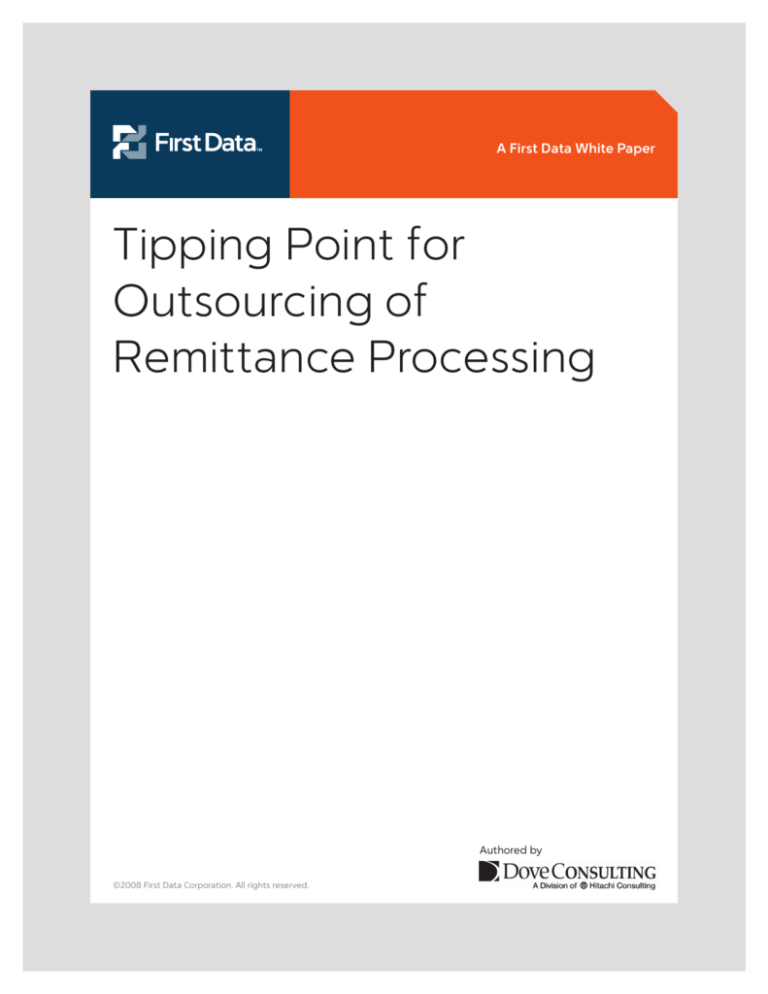
A First Data White Paper
Tipping Point for
Outsourcing of
Remittance Processing
Authored by
©2008 First Data Corporation. All rights reserved.
Rethinking the Case for Hosted IVR
A First Data White Paper
First Data Insights
Over the past 12-18 months we’ve seen an increasing number of businesses grappling with the issue of how
to cost effectively manage their in-house remittance operations given declining paper check volumes and
approaching obsolescence of their first generation image clearing systems. Investments clearly need to be
made to realize the benefits of ARC and Check 21 Image Cash Letters, but will those investments pay back
given that paper check volumes are forecast to fall by an additional 28 Billion by 2010?
Because so many businesses are currently developing strategies to tackle this challenge, First Data solicited
the experts at Dove Consulting to draw upon the latest remittance processing research to help add dimension
to the “Tipping Point” discussion. Is there a volume level at which in-house processing becomes less efficient
than outsourcing? Are there trigger points, like required upgrades or increasing transport costs that impact
when a company should consider outsourcing over in-house processing? We believe the answer to both
questions is “yes,” and have quantified the key decision points in this white paper which we hope will assist
companies to define future strategies for their lockbox operations.
Introduction
In-house remittance processing has reached a ‘Tipping Point’ where most
organizations will achieve lower cost per item through outsourcing than can be
realized with in-house operations. Currently, thousands of organizations still
operate in-house lockbox operations and have benefited from the innovative
technology and RP system that were developed during the 1990’s. However,
significant changes in the payments landscape and operating economics are
leading financial managers to conclude that it is better to outsource their
organization’s remittance processing function in order to focus their energy
and capital on strategic areas in their core business where they can grow
sales and margins.
©2008 First Data Corporation. All rights reserved.
firstdata.com
page 2
Rethinking the Case for Hosted IVR
A First Data White Paper
Evolution of Retail Lockbox Processing
Over the past four decades, large consumer billers have operated in-house remittance processing (RP)
facilities to process and deposit paper check payments that are received at their lockbox. During this period,
retail lockbox processing underwent a dramatic evolution as new methods were employed to improve
efficiency. Innovative use of the U.S. Postal Service led to the development of remittance mail handling that
sped up mail delivery to special PO boxes set up to serve high volume billers. Enhanced delivery and presorting
services reduced mail float and expedited processing of incoming mail received at lockboxes. The adoption of
standardized envelopes and remittance stubs with scan lines enabled high-speed extraction, and CAR/LAR
matching revolutionized bill payment processing by automating tedious manual activities. Together, these
techniques allowed billers to prepare deposits with encoded checks faster, reduce float, and save money on
bank fees while also efficiently posting customer payment to AR files.
As a result of these many innovations, remittance processing has become a highly sophisticated and
IT-intensive operation, which is expensive to manage, staff and maintain. Furthermore, recent declines in
check usage and ‘disruptive’ innovation in check processing are leading more billers to evaluate whether they
should outsource their remittance processing to a highly specialized third-party provider, who has already
invested in new systems, provides national coverage through sites distributed across the country, and can
share economies of scale by aggregating volumes from multiple lockbox customers.
Check 21 Image Clearing will Reach Critical Mass in 2008
The tragic events of September 11, 2001 spurred a series of events that reshaped the RP industry. When
the FAA grounded all commercial aircraft, the nation’s check clearing system was temporarily paralyzed as
check courier aircraft stood down. This crisis demonstrated that the United States needed a new method for
presenting transit checks for clearing to ensure that consumer and business payments could be completed
without the use of aircraft.
Check 21 provided the solution by granting Substitute Checks the legal equivalence of a payor’s original check.
The establishment of check image standards and format leveraged years of innovative work by the banking
industry and its suppliers to facilitate the rapid adoption of image clearing. With the effort of the Federal
Reserve and investments by check processors and clearinghouses, a national image clearing infrastructure
has been constructed over the past four years. As of December 2007, ECCHO reported that over 8,603 or 52%
of all U.S. financial institutions were capable of receiving check images for collection. The Fed expects 90% of
U.S. banks to be on board by 2010.
©2008 First Data Corporation. All rights reserved.
firstdata.com
page 3
Rethinking the Case for Hosted IVR
A First Data White Paper
Tipping Point in Paper-Based Remittance Processing
The RP industry has entered an era in which paper checks are no longer the most popular payment instrument.
The Federal Reserve Bank has estimated that volume of checks paid in the United States peaked around 1995
at 49.5 billion and steadily declined to 30.6 billion in 2006.
Figure 1. Growth of Non-Cash Payments in the U.S., 1979-2006
+42%
90
80
+103%
Payments (in Billions)
70
72.5
+44%
64.6
60
+175%
92.2
81.2
62.7
44.1
67%
30.7
15.1
50
40
30
35.1
5.5
-15%
+67%
-12%
20
10
-17%
49.5
41.9
36.7
2000
2003
30.6
29.6
33%
0
1979
1995
Checks Paid
Source: Federal Reserve Payment Studies 2001-2007
2006
Electronic Payment
In contrast, electronic payments accounted for 67% of all non-cash payments in 2006, up from a 54% share
in 2003. More importantly, between 2003 and 2006, electronic payments grew by 42%, while checks paid
declined by 17%. For remittance processors, this trend of paper checks displacement by electronic payments
will require profound transformation of their operations and economics.
Changing Bill Payment and Remittance Processing Landscape
The proliferation of bill payment options for consumers and fundamental changes in the U.S. check clearing
infrastructure are fueling an accelerating migration from paper check to electronic bill payments. For an
increasing number of billers, acceptance of recurring card payments, ACH check conversion (e.g., ARC,
WEB) and rapidly maturing Check 21-based image clearing systems have pushed paper-based remittance
processing toward an economic ‘Tipping Point’ where outsourcing is more attractive than updating their inhouse operations. As consumer bill payment behaviors change, most in-house retail lockbox operations have
experienced declining check volumes and rising costs per item. In this environment of declining volumes, it
has become increasingly difficult for in-house lockboxes to obtain the capital investment funding needed to
purchase newer and more robust RP equipment and software.
In-house lockbox operators will experience their own ‘Tipping Point’ when they can no longer realize
economies of scale, as paper item volume growth is captured by electronic payment methods. As paper
check volume declines, an increasingly diverse payment mix adds to the complexity of managing and
supporting multiple processing systems needed for integrating electronic payments. For many shops, their
last technological refresh occurred during Y2K preparations nearly a decade ago. Now, equipment is nearing
the end of its economic life and cannot easily be upgraded to generate Check 21 Image Cash Letter (ICL) and
ARC conversion files. The confluence of these factors is leading many to consider migrating some or all RP
activities to third-party providers.
©2008 First Data Corporation. All rights reserved.
firstdata.com
page 4
Rethinking the Case for Hosted IVR
A First Data White Paper
The Stressors: Market Trends and Volumes
Changing consumer behavior and infrastructure creates stress and uncertainty for lockbox managers, who
must determine appropriate solutions for their company’s needs.
Figure 2. Stress Factors Affecting Remittance Processors
Rising
Postal
Rates
ARC
Infrastructure
Changes
Remittance
Processor
Check 21
OCR
CAR
LAR
Rising Cost
of Paper
Deposits
Credit &
Debit Cards
Free Online
Banking
Consumer
Behavior
WEB & TEL
Changing Consumer Payment Preferences
Decision makers may find it useful to review industry volume trends and statistics, particularly those reported in
the Federal Reserve Bank of Atlanta’s Retail Payments Study (see www.frbservices.org/files/communications/
pdf/research/2007_payments_study.pdf). The introduction and adoption of electronic payment such as ACH,
credit cards and debit cards have fueled a rapid and dramatic transformation of the U.S. payments landscape.
Paper-based bill payments are steadily being replaced by an expanding array of electronic payment methods,
and consumers have shown a clear preference for more convenient alternatives at the point-of-sale and,
now, for bill payment. ACH payments have experienced strong growth as online bill pay and ACH eCheck
conversion programs continue to expand.
As consumers become more comfortable with using new technologies and applications, electronic-based bill
payment methods have become preferable to paper. Dove Consulting’s 2006 Consumer Payment Preferences
Study reported that paper-based bill payment methods were projected to fall to a 44% share in 2007, down
from 78% in 2001. The study also found that 45% of household bills were paid with electronic methods, a
nearly 40% increase from just two years prior.
©2008 First Data Corporation. All rights reserved.
firstdata.com
page 5
Rethinking the Case for Hosted IVR
A First Data White Paper
Figure 3. Paper-Based Bill Payments as Percent of Total
100%
80%
78%
65%
55%
60%
40%
45%
57%
44%
35%
20%
22%
0%
2001
2003
2005
Paper-based payments
Source: Dove Consulting
2007Pv
Electronic Payment
Consistent with this research, a study by the CheckFree Corporation reported that electronic bill payments
surpassed paper payments among consumers in 2006. Large billers in the credit card and telecom industries
reported similar statistics; their paper check bill payment volumes have declined to the mid-40% range. This
consumer adoption trend will likely continue unabated. Gwenn Bezard of the Aite Group predicts that the
percentage of bill payments made by paper checks and money orders will decline from 54% in 2006 to 37%
in 2010.
©2008 First Data Corporation. All rights reserved.
firstdata.com
page 6
Rethinking the Case for Hosted IVR
A First Data White Paper
Figure 4. Distribution of Payment Methods, 2006 vs. 2010
2006 Payments Mix
2010 Payments Mix
14%
28%
15%
14%
54%
9%
16%
37%
4%
9%
Check
ACH
Direct Debit
Credit/Debit
Cash
Source: Aite Group
Infrastructure Changes Requiring New Investments
Rapid changes in the payments landscape and the proliferation of payment methods are putting pressure
on remittance processors to manage their increasingly complex operations with limited resources. Per item
costs are beginning to rise due to declining volumes, creating a challenging business case for investing in new
systems needed to support in-house operations. Investment is necessary to achieve needed cost savings, but
the new payments environment has made it difficult to justify the capital outlays.
Realizing the benefits of ARC and Check 21 ICLs requires extensive system upgrades and process changes for
lockboxes, while continuing in-house operations in their current state will necessarily result in declining paper
item volume in the near future.
CFOs face the decision to either continue processing remittance in-house or outsource operations to a
third party. In-house operations will require additional investment in systems to capture the ARC and
Check 21 benefits, but this may lead to higher per item costs as volume falls. Meanwhile, outsourcing will
become increasingly attractive if they can retain control of key customer-facing activities and convert
fixed monthly operations costs with rising per item costs into a fixed cost per item expense that is easier
to plan and to budget.
The choice is one that organizations are reluctant to make. It can easily take a year to select an outsource
provider and to move the work into their lockbox facilities. After making the initial decision to outsource,
companies must also allocate approximately six months to evaluate and to select a vendor, and an additional
six months to upgrade or to switch over. While this decision can be difficult for organizations, the supporting
evidence clearly shows that the urgency and intricacy of remittance processing requires organizations to
decide on a course of action for this new payments environment.
©2008 First Data Corporation. All rights reserved.
firstdata.com
page 7
Rethinking the Case for Hosted IVR
A First Data White Paper
Check Volume Trends
The total number of paper checks written declined at an annual rate of 4.1% between 2003 and 2006. If this
trend continues, check volumes could fall to 28 billion by 2010. The rate of decline alone is manageable, but
seismic changes are occurring in the paper check clearing world. In December 2007, 57% of the Fed’s check
volume at collecting banks used image or substitute checks. Fred Herr, a leader of the Fed’s Check 21 team
recently reported that in February 2008, 60% of checks received by the Fed for clearing were presented as
images. He estimates that the percentage will reach 75% by December 2008 and that by 2010, 90% of checks
will be forwarded and settled as images—no paper items or Image Replacement Documents (IRD).
In September 2007, the Fed reported clearing as many checks images as paper items. As large banks switch
to image clearing, one analyst estimates that legacy paper item volumes could decline by as much as 50%
during 2008. With so few legacy paper checks remaining to be cleared, item fees will rise and availability levels
will decline at an accelerating rate. By 2009, there may not be enough paper checks remaining to justify the
remaining infrastructure.
Figure 5. FedForward vs. Legacy Paper Collection Daily Volume Trends
50,000,000
45,000,000
40,000,000
35,000,000
30,000,000
25,000,000
20,000,000
15,000,000
10,000,000
5,000,000
0
J05
A05
J05
O05
J06
A06
J06
O06
J07
A07
J07
Fed Forward
Source: Federal Reserve
O07
J08
Legacy Paper
The implication for lockbox operators is that Check 21 ICLs have now reached critical mass, as costs for image
deposits are headed down and paper deposits expected to increase sharply for the foreseeable future. For
non-bank lockbox operators, the business case for investing in new Check 21 systems is not as clear, since
they can leave the image clearing investment to their depository banks. However, the ability to provide the
properly formatted file to the ODFI serves as a reasonable and efficient solution.
First and second generation image transports still function, and with lower volume, work can be completed
by existing cut-off times with minimal holdover. However, Check 21 is disrupting cash letter cost and float
equations. Banks are allowing later cutoff times for check deposits and ACH files. Overlaying the new Remote
Deposit Capture options, depositors are revaluating the number and timing of their daily deposits to maximize
funds availability. However, for most operations, adding Check 21 and ARC capabilities will require significant
investment to replace equipment and image processing software and may change their hours of operations.
©2008 First Data Corporation. All rights reserved.
firstdata.com
page 8
Rethinking the Case for Hosted IVR
A First Data White Paper
Check 21 creates an opportunity for improving the function of lockboxes by reducing float and simplifying
operations. However, these changes also imply that traditional batch methods and the geographic dispersal
of multiple sites will be harder to realize internally. Lower image clearing fees and better availability schedules
have improved the business case for Check 21, sparking greater interest and implementation. However,
capitalizing on the benefits of Check 21 requires a strategic overhaul of fundamental operations and
organization. Of specific importance to remittance processors, the Fed is making three changes which directly
impact lockbox economics:
1. Convenience
As a result of declining check volumes, the Fed has undergone extensive consolidation of its check processing
sites. It has already downsized from 45 paper check processing sites to 18 and plans to further consolidate
into four sites by 2012.
Figure 6. Federal Reserve Check Processing Consolidation
X
X
X
X
X
X
X
X
X
X
X
X
X
X
X
X
X
X
X
X
XX
X
X
X
X
X
X Facilities closed or closing between 2003 and 2008
Source: Federal Reserve
2. Availability
Lockbox payments generally have a lower percentage of local items, so most items must travel to
out-of-district banks for clearing. As paper takes longer to travel for clearing, availability of paper items
will continue to decrease as transportation costs increase. In response to eroding economics, billers are
confronting difficult decisions to either invest in new systems to support ICLs, ACH and cards, or to outsource
their operations. The Fed has announced that they are reducing the number of Check Relay courier jet flights
and at some point may turn to the USPS mail for paper check transportation. These changes will slow down
the funds availability schedules for paper check items by days, tipping the balance toward ICLs which are
approaching same day availability.
©2008 First Data Corporation. All rights reserved.
firstdata.com
page 9
Rethinking the Case for Hosted IVR
A First Data White Paper
3. Pricing Incentives
The Fed’s pricing structure charges less for image items and much more for paper items, usually more that
twice that of image items. For 2008, the Fed announced a set of new prices to encourage image clearing:
- 12.5% increase in fees for forward collection of paper checks
- 10.3% increase in fees for collections with substitute checks
- 3.2 % decrease in fees charged for checks cleared as images
ACH Growth is Displacing Bill Payment Check Volume
ACH check conversion often costs billers less than $0.04 an item, which is less than the cost of encoding
and depositing paper checks. These cost savings and other factors have fueled the rapid growth of ACH for
consumer bill payment from approximately 2 billion payments in 2000 to almost 9 billion in 2007. In 2007, over
3 billion checks were ARC’d. Additionally, recurring and one-time ACH payment methods, such as PPD debits
and WEB transactions, eliminate the need for check writing and mailing payments to lockboxes, displacing
another 5 billion checks that might otherwise have been processed at a retail lockbox.
For billers, each new eCheck application erodes paper check volume and usually adds more complexities with
special rules that companies must follow as they manage A/R posting, exceptions, and bank reconciliation.
Figure 7. ACH Bill Payment Transaction Volume
157
396
9,000
163
347
Transactions (in Millions)
8,000
144
7,000
283
6,000
222
5,000
194
593
2,130
2,054
2,000
1,000
3,095
1,861
1,977
2000
2001
2,568
1,130
0
2002
2,941
2,763
147
3,000
1,605
1,190
846
4,000
2,058
CIE
TEL
WEB
PPD (Debit)
ARC
2004
2003
1,911
2005
2,543
2006
3,159
2007
190
Source: NACHA, Dove Analysis
©2008 First Data Corporation. All rights reserved.
firstdata.com
page 10
Rethinking the Case for Hosted IVR
A First Data White Paper
Online Bill Pay Pricing Driving Consumer Change
Biller websites and financial institutions have been promoting ‘free’ online bill pay to attract and retain retail
customers. This has encouraged consumers to utilize ACH and card-based payments rather than mailing
checks to lockboxes.
For consumers, the benefit of ‘free’ online bill payment is direct. In contrast, the U.S. Postal Service has steadily
increased first-class postage rates. For a typical household, sending all bill payments via mail with $0.41
stamps (soon to be $0.42) would cost $6.21 in postage each month, amounting to $74.54 per year. With rate
hikes likely to continue for the foreseeable future, the value proposition for consumer online bill payment will
continue to improve while paper payments deteriorate.
Figure 8. First-Class Mail Postal Rates
$0.50
$0.40
$0.30
$0.20
$0.10
$0.00
1998
1999
2000
2001
2002
2003
2004
2005
2006
2007
2008
Source: United States Postal Service
Outsourcing Rationale
Need for New Technology
The majority of lockbox operations last refreshed their technology almost ten years ago, and the equipment
has begun to deteriorate and require more maintenance. Most in-house lockboxes are using imaging transports
and systems that predate the passage of Check 21 and ARC. The implementation of image archiving was done
primarily with CD-ROMs. While the benefits of new image capture systems are appealing, implementation
requires significant investment of resources that may not be available. Nevertheless, for lockboxes,
technological updates are necessary in order to support electronic check processing.
Before procuring a new IT-centric system, most organizations must first establish the scope of system
requirements and determine the capacity needed. Then they would need to develop a capital budget request
detailing the amount of investment needed, rationale for the effort articulated, labor savings estimated, and
anticipated ROI or payback period analyzed.
©2008 First Data Corporation. All rights reserved.
firstdata.com
page 11
Rethinking the Case for Hosted IVR
A First Data White Paper
Challenging Business Case
But what happens when volume is expected to decline steadily over the capital investment analysis timeframe,
and there is a risk of needing to write off stranded or obsolete assets with uncertain residual values? This is
new territory for organizations and has led some to shorten the estimated useful life for RP systems from seven
years to as few as three, raising the required savings to achieve an acceptable return on investment.
Before online bill payment arrived on the scene, lockbox operators could easily justify the acquisition of labor
saving second-generation equipment for extracting mail; advanced OCR technology could dramatically
reduce the amount of labor required in a lockbox as the systems can ‘kill’ up to 70% of payments without
human intervention. New systems could boost productivity by more than 30% from first-generation ‘read
and key’ systems, and those durable systems were built to run for decades. However, for RP shops that have
already benefited with big savings from ‘read and key’ to second-generation systems with powerful CAR/LAR
engines, the 10% productivity gain from upgrading to third-generation systems with ARC and ICL capabilities
is not as dramatic.
Figure 9. Estimated Productivity Gains by Generation
+10%
+30%
Gen 1
Gen 2
Gen 3
Source: Dove Analysis
Need to Reduce Costs
In-house lockbox operations are being squeezed by equipment that is nearing the end of its economic life,
labor costs that are rising 3% to 5% annually, and declining monthly paper item volumes. These converging
cost pressures make it harder to create the compelling business case needed to get funding for a technology
refresh. Unless an in-house RP operation is picking up volume from new customers through mergers or their
company’s rapid growth, there is limited potential for increasing item volume. The steady 2% to 6% decrease
in annual volume that most lockboxes have experienced makes it difficult for the improved productivity gains
achieved from third-generation RP systems to offset the additional investment costs.
For many mid-sized in-house RP shops. there will be a net negative financial impact because they will not
recoup the investment as easily as in that past. However, if no action is taken, per item expenses will inevitably
increase as overhead is recovered over lower monthly volumes. Given this dilemma, it is no longer a matter of
whether most in-house operations will consider outsourcing but rather how soon they will do it.
©2008 First Data Corporation. All rights reserved.
firstdata.com
page 12
Rethinking the Case for Hosted IVR
A First Data White Paper
Of course, what they may choose to outsource will depend on each organization’s mix of consumer and
business customers. Organizations with mostly B2B customers may choose to update their systems to support
automated mail extraction and improved data capture by acquiring updated full-page scanning and/or by
adopting more wholetail-oriented systems. According to the Fed, there are approximately 8 billion B2B checks
being sent each year. B2B volumes are declining at a slower pace than consumer lockbox payments and have
a higher dollar value. This indicates that business checks will continue to be an increasingly important source
of lockbox volume. Although B2B checks are more challenging to convert into ACH payments, the adoption of
wholetail techniques should provide opportunities for growth and value-added image-based services.
What to Outsource
During this transitional period, organizations must examine their priorities, determine which activities are core
to their business strategy, evaluate the value of business processes, and provide competitive advantage.
For many, certain activities can be performed faster, better, and cheaper through the use of third parties
that specialize in tasks such as mail sorting, opening, imaging, and preparing paper items for deposit or ACH
conversion using ARC or BOC. A few minutes of work on new high-speed mail opening and image extraction
equipment can replace hours of labor-intensive extraction and read-and-key work at low volume in-house
lockboxes. This allows companies to free internal staff to focus on core business activities and to extract the
benefits without devoting significant resources to performing these tasks in-house.
The 2005 Remittance Processing Benchmarking Study indicated that labor accounts for 58% of a non-bank
lockbox’s expenses.
Figure 10. Monthly Operating Budget Mix for Non-Bank RP Sites
Labor
58%
Labor
Hardware
Bank Deposit Fees
Facilities/Occupancy
Software
Other Overhead Expenses
Supplies
Express Delivery & Third-Party Courier
Vehicle & In-house Courier
Miscellaneous
Source: TAWPI/Dove Consulting, 2005
Although labor rates differ by activity, 68% of paid hours were spent performing four tasks: Mail Prep,
Extraction, Keying, and Balancing. These capture-and-keying activities can be readily and efficiently
performed by an outsourcer. Moreover, new availability policies for ARC and Check 21 ICLs have created
an opportunity to extend cut-off times.
©2008 First Data Corporation. All rights reserved.
firstdata.com
page 13
Rethinking the Case for Hosted IVR
A First Data White Paper
Table 1. Paid Hours by Activity (Per Site)
Activity
Percentage of Paid Hours
Cumulative
Mail Prep
5%
5%
Mail Opening
31%
36%
Keying
28%
64%
Transaction Balancing
4%
68%
Encoding
6%
74%
Sorting
0%
74%
Deposits
4%
78%
Cash Letter
0%
78%
Account Reconciliation
1%
79%
Exceptions Research
7%
86%
Posting
1%
87%
Return Items
1%
88%
Bank Advices/Investigations
1%
89%
Address Change
1%
90%
Other
9%
100%
Total Paid Hours
100%
100%
Source: TAWPI/Dove Consulting, 2005
Declining Volume and Loss of Economies of Scale
Businesses must recognize that volumes must offset the costs of overhead and investment in order for
in-house operations to be worthwhile and sustainable. The late John Black, former Chairman of the Board
of TAWPI and the first chairman of its Payments Capture and Clearing Council, observed, “[I]t comes down
to scale. For businesses with less than [1 million per month in volume], the overhead is much higher and,
of course, less economy of scale.” Under these circumstances, outsourcing may provide greater value than
continuing in-house operations for remittance processing.
For small to mid-sized companies, this means that outsourcing may be the more viable option, given their
comparatively low volumes and high costs. It has been estimated that approximately half of these organizations
have outsourced RP activities to third parties, with the other half retaining in-house operations. However,
with volumes in a state of decline, this balance will likely tip toward outsourcing as companies decide that
diminishing volumes cannot justify the cost of keeping operations in-house.
In an environment where volume is declining, outsourcing allows customers to get both the benefits of
new technology and a more predictable cost per item. Thus, companies need to realistically assess their
current and future volumes when deciding whether to continue in-house RP operations or to outsource to a
third-party provider.
©2008 First Data Corporation. All rights reserved.
firstdata.com
page 14
Rethinking the Case for Hosted IVR
A First Data White Paper
In-House Remittance Processing Cost Curve
Figure 11 shows the relationship between per item costs and monthly volume for 25 in-house lockbox operations
from the most recent benchmarking data available. Each data point represents an organization’s reported
cost per item and monthly volume. Together, they show that per unit costs decrease as volume increases and
conversely increase as monthly volume decreases, with a mean cost of $0.184 per item. The blue regression
line shows the statistically significant relationship between per item costs and monthly volumes (r2=52%).
The curve shows that as an average lockbox’s volume declines, the per item costs will increase; for every 10%
decrease in monthly volume, per item costs will increase by approximately 2.7%, without factoring increases in
labor expenses or new equipment acquisition costs.
Figure 11. In-House Lockbox Cost per Item vs. Monthly Volume
$0.60
Cost Per Item
$0.50
$0.40
Mean=$0.184
$0.30
$0.20
$0.10
R Sq Linear = 0.52
$0.00
100,000
1,000,000
10,000,000
Monthly Volume
Source: Dove Analysis
2008 Should Be a Big Year for Outsourcing
Evidence suggests that 2008 will be a busy year for outsource providers as in-house shops evaluate their
strategy for obtaining third-generation image capture technologies to support ICLs, remote keying, and
improved ARC decisioning and conversion rates. This will lead to an abundance of Requests for Proposal (RFP)
issued by organizations with in-house lockbox operations.
Consider the Big Picture
Organizations often fail to look at the big picture when making the decision between processing remittance
in-house and outsourcing. Most look at it from a narrow financial perspective, but there are many factors that
should influence the decision, including staffing, customer service, and security. Only by viewing remittance
holistically and in the context of the entire business process can organizations make an informed decision.
Although the decision to outsource remittance processing depends on market pressures and a company’s individual
outlook, the trend toward moving in-house operations to a third party is also a reflection of the overall move toward
outsourcing all non-core activities. Increased receptiveness to outsourcing in general makes the business case for
doing the same with remittance processing more appealing. Outsourcing these activities may be perceived as an
inevitable next step in retooling business operations. John Black suggested that a “CFO may decide to look at the
bigger picture of BPO, giving up not only remittance but also many other financial functions.”
©2008 First Data Corporation. All rights reserved.
firstdata.com
page 15
Rethinking the Case for Hosted IVR
A First Data White Paper
Outsourcing Assessment
Many in-house billers are examining the costs and benefits of outsourcing all or part of their RP operations
to reduce the need for capital investment in the next generation of hardware and software while obtaining
the benefits of new image based Check 21 and ACH check conversion systems. In response, senior financial
and RP managers are gathering information about their options through Requests for Information (RFIs) and
competitive RFPs for two options:
JJ Updating their in-house systems
JJ Outsourcing their lockbox operations
In general, the largest and smallest lockbox operators are finding that it is most financially beneficial to either
invest in new systems or defer the decision. However, mid-sized and large in-house lockboxes are finding
that outsourcing can reduce their per item costs while ensuring that those costs can be maintained through
contractual terms. In contrast, investing in new systems will increase their per item costs. In some cases, this
can be to the point where a new in-house system costs twice as much as what they could have obtained from
a third-party lockbox provider.
Figure 12 illustrates the economic equations that are driving remittance processing past its ‘Tipping Point’ in
favor of outsourcing. As volumes fall, an organization can take advantage of market prices to keep per item
cost relatively flat by outsourcing. That would let an organization move toward position ‘O’ on the graph. If an
organization purchases a new system, their costs will move toward position ‘N,’ and if they do nothing, their
costs will rise.
Figure 12. Impact of Outsourcing on Per Item Costs
$0.45
Outsourcing
Current Cost
New System
$0.40
Cost Per Item
$0.35
$0.30
N
$0.25
$0.20
$0.15
O
$0.10
$0.5
$0.00
0
1,000,000
Source: Dove Analysis
2,000,000
3,000,000
4,000,000
Monthly Volume
As seen in Figure 12, the financial benefits of outsourcing are clear. For instance, most organizations with
monthly volumes from in-house retail lockboxes between 400,000 and 2.5 million items will see significant
advantages in outsourcing, which would allow them to focus on core business and to relegate non-core
activities to a less costly provider.
©2008 First Data Corporation. All rights reserved.
firstdata.com
page 16
Rethinking the Case for Hosted IVR
A First Data White Paper
Outsourcing also allows organizations to mitigate the risk of increased unit costs due to declining volumes in
the long-term. By obtaining a fixed multi-year contract, they transfer this problem to their provider and are
able to reap the benefits while offloading the financial risk.
Options to Consider for In-House Operations
Maintain Status Quo
Based on industry trends and pressures, continuing in-house operations in their current state appears to be
an unsustainable strategy in remittance processing. The number of paper checks received by retail lockboxes
is declining at a rapid rate, as consumers continue to migrate to electronic bill payment methods. This will lead
to an inexorable annual increase in per item costs.
Add External Volume
Some organizations have been able to grow their own monthly volume by taking on outside work from other
lockbox operators. While this is a more viable option than maintaining the status quo, adding external volume
also requires additional strategic considerations, some investment, and implementation of new tasks. This
will include new costs for sales and marketing, billing, administration, reporting, and customer services,
which may outweigh the benefits of adding volume. John Black observed that providing services for other
lockbox customers “may help get some incremental business for the smaller operations that were thinking
about upgrades, but they are then forced to go through the business case of looking at an upgrade versus
outsourcing.” This option essentially defers the outsourcing decision for perhaps two to three years.
Adopt a Selective Outsourcing Approach
When considering outsourcing, organizations must identify what matters to them and what can be seamlessly
outsourced to a third party. For most organizations, activities that ultimately affect their customers, namely
exceptions handling, are of highest value. Lower-value activities such as mail extraction, capture, and data
entry comprise a large percentage of labor hours and may be the most suitable option for selective outsourcing
because providers can perform these tasks at higher efficiency and at lower cost. Online exception processing
allows the biller to maintain control of the sensitive areas that affect customers. Tasking the outsourcer with
activities that yield the biggest rewards from economies of scale also frees managers to focus on high-value
activities that help retain customers and enables organizations to maintain control over the operations that
matter most.
©2008 First Data Corporation. All rights reserved.
firstdata.com
page 17
Rethinking the Case for Hosted IVR
A First Data White Paper
Benefits and Considerations
Each organization should evaluate its alternatives in light of the benefits and considerations outlined below:
Benefits of Outsourcing
JJ Reduce cost of operating and maintaining RP systems and technology
JJ Utilize new technologies as they become available (e.g., Check 21 ICLs, ARC, Image Archiving, etc.)
JJ Transfer challenges with staffing, systems conversion, and training issues to a specialist
JJ Minimize risk of increased per item costs as volume decreases
JJ Provide business recovery and contingencies for facility service interruptions
Considerations
JJ Diminished control: Are all of your items being processed the same day, every day?
JJ Big Fish/Little Fish: How responsive will your provider be to your needs?
JJ Willingness to support selective outsourcing and service level agreements
JJ Exception processing: Do you and your provider agree on the definition of ‘exception’? Do they have the
ability to let you maintain control?
JJ Pricing over the long-term
JJ Stability and continuity of outsourced providers
JJ Process for changing procedures and services
Ultimately, the decision to outsource should rely on considerations that take into account all factors important
to a company’s strategy. Identifying the outcomes, maintaining realistic expectations, and, most importantly,
effectively communicating these issues to potential providers also increases the likelihood of a beneficial
relationship. When companies approach decision-making holistically, outsourcing can provide great value and
yield success for a company.
©2008 First Data Corporation. All rights reserved.
firstdata.com
page 18
Rethinking the Case for Hosted IVR
A First Data White Paper
Call to Action
Create and Evaluate a Payments Migration Strategy
New rules and payment methods are added every year, and, as a result, the complexity of RP operations
has increased exponentially. The changes occurring in remittance processing—and the payments industry at
large—make it absolutely essential for RP managers to act as key players in the development and execution
of their organization’s payments strategy. As consumers and businesses increasingly utilize multiple payment
methods, there will be strategic and competitive benefits for organizations that can effectively coordinate
and manage this critical aspect of customer interactions and relationships.
Questions to Consider
JJ How much longer will customers continue to pay with paper checks in large volumes to justify new systems
and in-house operations?
JJ How will you continue to absorb increasing unit costs year after year?
JJ What is your strategy and how will you react to the myriad of pressures in this new payments environment?
JJ What is your organization doing to prepare as the lockbox world reaches a very different ‘future-state’?
JJ Will you be able to capture the benefits?
JJ What are you waiting for?
©2008 First Data Corporation. All rights reserved.
firstdata.com
page 19
A Global Leader in Electronic Commerce
First Data powers the global economy by making it easy, fast and secure for people and businesses around
the world to buy goods and services using virtually any form of payment. Serving millions of merchant
locations and thousands of card issuers, we have the expertise and insight to help you accelerate your
business. Put our intelligence to work for you.
About Dove Consulting
Founded in 1981, Dove Consulting, a division of Hitachi Consulting, is a Boston-based consulting firm specializing
in financial services. A leader in developing retail payments, distribution, and customer strategies, the group has
performed payment strategy work with seven of the Top 10 U.S. banks, credit unions, major payment networks and
processors, and government entities.
Dove’s value proposition—deep expertise for immediate value, sincere collaboration with clients, and the delivery of
clear results—has enabled the firm to become a highly valued and trusted advisor to leading financial institutions,
networks, processors, and other providers all over the world.
Client consulting work at Dove is supported by an ongoing commitment to industry research. The firm’s primary
research has addressed payment trends related to consumers, retailers, ATM deployers, card issuers, businesses,
government agencies and remittance processors.
About First Data Services/REMITCO
REMITCO, a First Data company, is the leading provider of third-party payment processing in the country, operating
a seven-site network designed to reduce mail float and time in process. REMITCO offers a comprehensive payment
processing solution that provides inherent flexibility to manage changes in consumer behavior while taking advantage
of advanced electronic functionality.
REMITCO is focused on simplifying the transition from paper to electronics for companies of all sizes in all industries.
For more information, contact your
First Data Sales Representative
or visit firstdata.com.
©2008 First Data Corporation. All Rights Reserved. You may not disclose, copy or use any part of these materials for any purpose without
the express written consent of First Data Corporation. All trademarks, service marks and trade names referenced in this material are the
property of their respective owners.
firstdata.com
page 20

